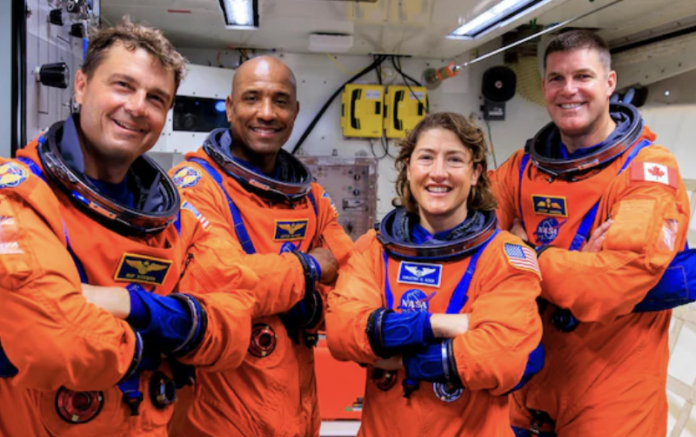Зворотний відлік до наступної подорожі Америки на Місяць, швидше за все, знову затягнеться.
Аудитори GAO прогнозують дату запуску на початку 2027 року, якщо розробка піде за звичайним графіком NASA. В даний час NASA має “амбітний графік … На 13 місяців коротше, ніж у середньому”, – написали в GAO. «Складність польоту людини в космос говорить про те, що нереалістично очікувати, що програма завершить розробку більш ніж на рік швидше, ніж в середньому для великих проектів NASA, більшість з яких не є проектами польотів людини в космос». У той час як NASA сподівалося просунутися швидше, ніж зазвичай, GAO заявила, що програма «досягає ключових подій повільнішими темпами».
Фактично, запуск у 2027 році буде ближчим до початкової мети NASA у 2028 році. Це було до березня 2019 року, коли за президента Дональда Трампа «Білий дім наказав NASA прискорити свої плани щодо висадки на Місяць» до 2024 року, згідно з аудитом, «частково для того, щоб створити відчуття терміновості у поверненні американських астронавтів на Місяць».
У листопаді 2021 року NASA перенесло посадку щонайменше на 2025 рік. Космічне агентство заявляє, що Artemis III стане першою місією на південний полюс Місяця і “висадить першу жінку та першу кольорову людину на поверхню Місяця”, водночас зазначаючи, що їхній вибір ґрунтуватиметься на правильному екіпажі для місії. До сих пір всі 12 місячних ходів були білими американцями.
NASA офіційно не оголосило про перенесення, але визнало цю ймовірність в електронному листі The Washington Post. Агентство заявило, що працює зі своїми партнерами “над розробкою графіка шляху до Artemis III”. … Усі підрядники та партнери для різних елементів Artemis повинні вчасно виконати завдання для успіху місії та цілей агентства з розвідки».
Це дуже хитромудрий проект. Різні ускладнення можуть перешкодити своєчасним авіаперельотам з одного міста в інше, але це ніщо в порівнянні з переміщенням екіпажу людей на відстань 238 855 миль в нелюдське середовище.
«Місія Artemis III є третьою в серії все більш складних місій, спрямованих на підтримку лідерства США в освоєнні космосу, створення стійкої присутності на Місяці протягом наступного десятиліття, — заявили в GAO, — і, зрештою, подорожі на Марс».
● Затримки з «ключовими подіями». Серед них – знищення апарату SpaceX, центрального для місячної місії, який “почав розпадатися приблизно через 4 хвилини польоту після того, як апарат відхилився від очікуваної траєкторії, втратив висоту і почав падати” під час орбітального льотного випробування у квітні. Вісім з 13 ключових подій у розвитку системи посадки були відкладені на 13-<> місяців.
● Виклики дизайну. Компанія Axiom, підрядник скафандрів, також стикається зі значними проблемами. “Наприклад, оригінальна конструкція NASA не забезпечувала мінімального обсягу екстреного життєзабезпечення, необхідного для місії Artemis III”, – заявили в GAO. «У результаті представники Axiom заявили, що вони можуть змінити деякі аспекти скафандра, що може затримати його доставку для місії».
Рассел Ралстон, віце-президент Axiom, повідомив електронною поштою, що компанія «активно займається інноваційною роботою» над технологіями скафандрів, «необхідними для підтримки 60 хвилин екстреної підтримки життя». Як зазначається у звіті, це перспективна робота, яка може зайняти додатковий час».
Крім того, додав він, “затримки є частиною загальної схеми в програмі”.
Згідно з поточним графіком, програма NASA «Місяць на Марс» включає сім місій Artemis до 2031 року. Розклад кожної місії залежить від попередніх місій. «Артеміда» I і «Артеміда II» відставали від графіка. Артеміда III успадкувала їх запізнення. У вересні 2022 року GAO виявила, що «NASA кілька разів відкладало терміни місії Artemis і ключові етапи програми. … Затримки із запуском Artemis I мають каскадний вплив на графіки місій Artemis II і III, оскільки між цими місіями потрібен мінімальний час. NASA також відклало місію Artemis II на травень 2024 року, на 13 місяців пізніше початкової дати запуску у квітні 2023 року.
Але як тільки всі перегини будуть опрацьовані, «ця місія відкриє майбутнє, в якому люди будуть постійно отримувати доступ до Місяця», прогнозують в NASA, «а місії з дослідження планет будуть в межах досяжності».


